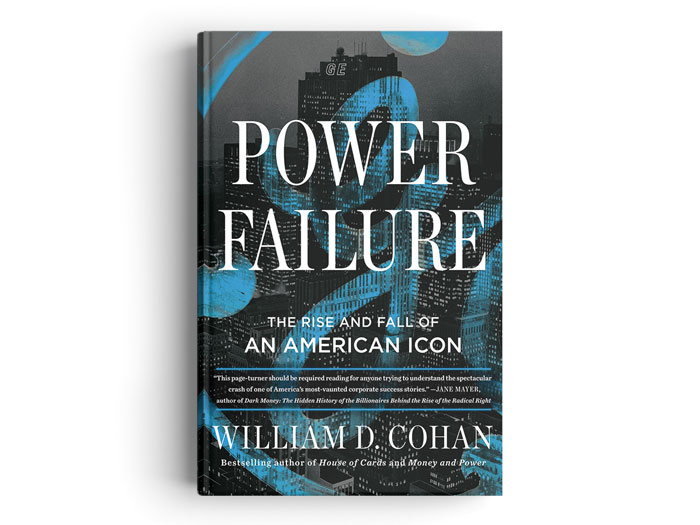New book sheds light on the rise and fall of General Electric
 There is detail beyond detail in Cohan’s description of time, place and key figures in his magisterial book
There is detail beyond detail in Cohan’s description of time, place and key figures in his magisterial book
In all U.S. history, no other conglomerate has resonated in both American mythology and real life as General Electric. From the light bulb to jet engines, and from founder Thomas Edison to former CEO, the Fortune magazine-dubbed “manager of the century” Jack Welch, GE became the most admired and valuable company in the world. It was, in the minds of many, the embodiment of U.S. ingenuity, innovation, and industrial power—the American century in a microcosm.
Two decades post-Welch, General Electric is poorer, with a quarter of its share price in 2000, smaller—its domestic labour force down to 70,000 workers from 277,000 in 1989—and about to shrink further as it divides into three independent companies. In 1896, GE was one of the first 12 companies to form the Dow Jones Industrial Average; in 2018, the last of the originals, it fell out of the index after a 122-year run.
How General Electric got from there to here, is no easy story to tell, but financial journalist William Cohan does a spectacular job in the near-800 compulsively readable pages of Power Failure: The Rise and Fall of an American Icon. One of the book’s strengths is its deep dive into GE’s early years during the first Gilded Age. The late 19th-century era of vast fortunes and economy reshaping resembles our own in more than a rising tide of inequality.
In the popular mind, it was Edison’s scientific genius that started GE on its way, but as Cohan sets out, it was GE’s other parent—the restless entrepreneur Charles Coffin—who launched their child into the future. Coffin successfully wrestled with the eternal problem of tech start-ups: a potentially revolutionary and lucrative product without an established market. It was as hard then, Cohan writes, to convince people that electric light was preferable to whale oil as it was, not so long ago, to convince them to use the internet.
Coffin’s company built small and cheap power plants everywhere it could, making electricity far easier to try out. His financial innovations—a kind of vendor financing familiar today—and aggressive acquisitions got it afloat. When sued for patent infringement, he responded by buying the plaintiff’s company. When his better-managed firm started butting heads with Edison’s more innovative company, Coffin approached the inventor’s many financial backers and forced a merger. GE was on its way—and soon without the sidelined Edison. Coffin’s “financial engineering,” as Cohan calls it, not only saw the company through two major financial crises before the First World War, but also sank deep into GE’s DNA.
By the time he reaches the rise of Jack Welch, CEO from 1981 to 2001, Cohan has taken readers through extraordinary technical innovations—the first American jet engine, for one—massive growth, a handful of unexceptional scandals and some quirky leadership. All of which exploded under Welch, a human accelerant.
That was especially true of GE Credit, a Coffin-style means of financing individual consumer purchase of household electric appliances during the Great Depression. When Welch arrived, the newly renamed GE Capital had 7,000 employees and $67 million in annual earnings; when he left, four days before 9/11, there were 89,000 employees generating $5.2 billion annually, more than half GE’s profits—enough for some observers to think of the conglomerate as a finance company with a few industrial holdings.
Welch was famous in the media—called Neutron Jack, in reference to the notorious people-killing but building-sparing bomb of the era—for decimating GE’s workforce without demolishing (or so it seemed) its core structures. But he was revered among investors for his true fanaticism, the way he insisted on “smoothing” the company’s annual earnings reports, so that GE never missed a Wall Street projection or saw its shares drop in value. What went on behind the scenes to keep that remarkable string going—a sale and a later buy-back here, an over-valuation there—went unseen or ignored. No competitor innovated a better jet engine, no one at GE engineered a massive and outright fraud, but the mismanagement couldn’t go on forever. When the financial crisis of 2008 struck, the freefall began.
There is detail beyond detail in Cohan’s description of time, place and key figures in his magisterial book. But there is one moment with Welch that seems to capture, in exquisite metaphor, the entirety of Power Failure. As 82-year-old Welch drove Cohan home from a Nantucket golf club, the author watched as Welch sat on his seat belt while its warning bell kept sounding (“I hate those things”), and then took to steering down the middle of the two-lane road, the better to facilitate his coming left turn. Approaching drivers—like fellow GE executives, business rivals and government regulators before them—simply got out of his way.
BUILD YOUR LIBRARY
Dig deeper into the big data conundrum with Tim Harford’s The Data Detective. And learn more about the disturbing rise of fake news in Sinan Aral’s The Hype Machine.